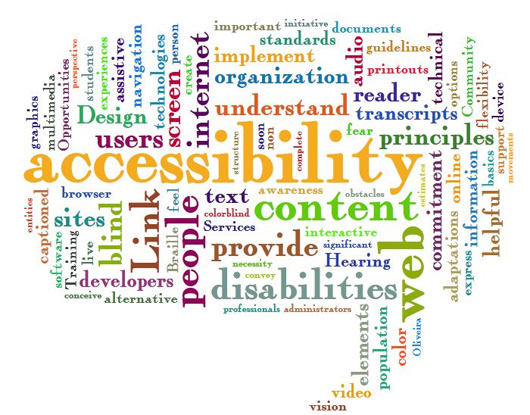Designing For Disabilities: Section 508 and International Accessibility Compliance For Beginners


Many graphic designers, web developers, or others in the technology and media industries will eventually come across a project that requires compliance with “Section 508” or other accessibility standards. This term can be quite intimidating for a beginner because of the legal implications often involved. While Section 508 is legally binding only for United States federal agencies or those funded federally, often an organization that provides public services will request a website or software that meets the requirements for Section 508.
What is Section 508?
In 1998, United States lawmakers signed into law the new Section 508 of the Rehabilitation Act of 1973, which improved the original Section 508 Amendment that was added to the Rehabilitation Act in 1986. In 2001, even more changes were made. The Electronic and Information Technology (EIT) Accessibility Standards was published along with amendments to the Federal Acquisitions Regulations (FAR). History and legal logistics aside, these rules and regulations require federal and federally funded agencies to provide people with disabilities easy access to electronic and information technology. Basically, a law was put into place to provide equal opportunities for people with disabilities. Federal employees with disabilities or members of the public using Federal information and technology now have the same access as others.
Why Does it Affect Designers and Developers?
Since Section 508 applies to United States Federal software, hardware, downloads, websites, documents, etc., a designer or developer may come across projects requiring Section 508 Compliance in the brief. Some non-Federal agencies, while not legally required to be 508 compliant, may also request that a project meet these outlines, especially if the agency provides public services or their target market includes a high amount of people with disabilities.
If you have recently acquired a client that is in need of a design that meets Section 508 requirements, don’t be too intimidated. It can sound difficult or scary to learn, but it just requires careful adherence to a set of compliance rules, many of which are already best practices. For instance, web images must have an alternative (“alt”) description that is not too lengthy, doesn’t repeat other text on the page, and accurately describes the image. Certain color requirements have to be followed to make sure that text is readable by people with color blindness or other vision disabilities. The difficult part of following Section 508 requirements is in finding an easy-to-follow list with clear, concise rules.
Another consideration to keep in mind is that Section 508 is the bare minimum for making a document or website accessible to everyone. A diligent designer will also make sure that it is easy to navigate and looks appealing, just as with any other design. So, you may also want to check out the W3C’s Web Accessibility Initiative (WAI) guidelines. These guidelines are excellent for helping you to create internationally accepted standards for web accessibility.
How Do Designers Make Designs Section 508 Compliant?

Photo Credit: Fey Ilyas via Compfight cc
Section 508 has three main requirements to meet:
- Technical – these requirements make sure the coding of a website, software, operating systems, etc. is compatible with assistive technologies.
- Functional – these requirements ensure that in addition to the technical coding, the entire system is usable by someone with a disability.
- Support – these requirements make sure that support documents and alternative information is also accessible by people with disabilities.
If a project doesn’t meet all three of these requirements, then it is not legally compliant.
The official Section 508 compliance guidelines is available for you to reference if needed. In addition, the following are some excellent resources for quickly learning how to make your document 508 Compliant, including sites that test your work to make sure your project meets requirements:
- United States Access Board – The Section 508 Standards of this site provides an excellent detailed explanation of the three different requirements we discussed above. The Guide to Section 508 Standards on this site allows you to choose the specific type of technology you are designing and gives detailed explanations and examples of the standards.
- JimThatcher.com – This site provides an excellent, free course for learning what it means to make website designs 508 compliant. Lots of excellent real life examples are included and explanations are easy to understand.
- Webucator.com – This site is an excellent source for low cost but thorough training for web accessibility and Section 508. However, they also offer a free tutorial on Section 508 for those who want to learn on their own.
- SSB Bart Group – Another option for excellent training and classes on accessibility is available through this group, but you can also test your site for accessibility, including if it meets Section 508 standards, for free. They also provide a good explanation of Section 508.
- HowTo.Gov – For scores of excellent information, visit the HowTo.Gov website, which includes basic overviews as well as tutorials and resources on making sure everything from a website to multimedia is 508 Compliant. You may also want to check out this video on No Fail Accessibility Testing.
- WebAIM – This site provides a good 508 compliant checklist for HTML, Scripts, Plug-ins, Java, and more. The checklist includes links to further explanation of certain standards.
- Viget.com – For a basic overview of accessibility and 508 compliance in web design, Viget offers an easy to understand article on the subject. This is an excellent place to start, since it clears up common misconceptions.
- U.S. HHS – The U.S. Department of Health & Human Services gives an excellent overview of Section 508 as well as step-by-step tutorials and testing.
Know What Training You Need
Your clients that require 508 compliance in their documents, websites, or software will need you to have expertise and experience in complying with 508 guidelines. So, if you want to list Section 508 as one of your skills or proficiencies, you might consider following them even on projects that don’t specifically benefit from or require you to adhere to those accessibility standards for your own edification.
If your clients are ones that aren’t legally required but still want to follow Section 508 standards for accessibility purposes, then you can probably get by with teaching yourself the guidelines and use free testing resources. However, if you are looking at picking up projects for Federal clients, or clients seeking Federal funding, then you probably will need to complete official classes and training just to make sure that you can adequately fulfill your client’s needs.
Do you have any helpful resources for learning Section 508 compliance? How does Section 508 compare to international accessibility standards? Do you find these standards to be tedious and troublesome, or do you think they’re important and overlooked?
Frequently Asked Questions (FAQs) on Designing for Disabilities and Section 508 Compliance
What is Section 508 and why is it important?
Section 508 is a part of the Rehabilitation Act of 1973, which requires federal agencies to make their electronic and information technology (EIT) accessible to people with disabilities. This is important because it ensures that everyone, regardless of their physical abilities, can access and use public information and services. It promotes inclusivity and equal opportunities for all.
How does designing for disabilities benefit businesses?
Designing for disabilities, also known as accessibility design, benefits businesses in several ways. It expands the customer base by making products and services accessible to a wider audience. It also improves the overall user experience, as accessibility features often make a product easier to use for everyone. Additionally, it helps businesses comply with legal requirements, avoiding potential lawsuits and penalties.
What are some key principles of accessible web design?
Accessible web design is based on several key principles. These include perceivability (ensuring users can perceive the information being presented), operability (making sure users can operate the interface), understandability (the information and operation of the interface must be understandable), and robustness (the content must be robust enough to be interpreted reliably by a wide variety of user agents, including assistive technologies).
How can I test my website for Section 508 compliance?
There are several tools and methods available to test your website for Section 508 compliance. These include automated testing tools, manual testing, and user testing. Automated tools can quickly identify some common accessibility issues, while manual testing and user testing can provide more detailed insights into the user experience.
What are some common mistakes in accessibility design?
Some common mistakes in accessibility design include not providing alternative text for images, not ensuring sufficient color contrast, not making all functionality available from a keyboard, and not providing captions or transcripts for audio and video content. These mistakes can make it difficult or impossible for people with certain disabilities to use the website.
How can I make my website more accessible?
There are several strategies to make your website more accessible. These include using semantic HTML, providing alternative text for images, ensuring sufficient color contrast, making all functionality available from a keyboard, and providing captions or transcripts for audio and video content.
What are the penalties for not complying with Section 508?
Non-compliance with Section 508 can result in a variety of penalties, including lawsuits, financial penalties, and damage to the organization’s reputation. It’s important to note that Section 508 applies to federal agencies, but many states and private businesses also follow these guidelines to ensure their websites are accessible.
What resources are available to help with Section 508 compliance?
There are many resources available to help with Section 508 compliance. These include the official Section 508 website, which provides guidelines and resources, as well as various online tutorials, guides, and tools. Many web development agencies also offer accessibility consulting and testing services.
How does international accessibility compliance differ from Section 508?
International accessibility compliance, such as the Web Content Accessibility Guidelines (WCAG), often goes beyond Section 508 requirements. For example, WCAG has guidelines for mobile accessibility and more detailed guidelines for certain types of content. However, Section 508 has been updated to align more closely with WCAG.
How can I stay updated on accessibility standards and best practices?
Staying updated on accessibility standards and best practices can be achieved by regularly visiting official websites like Section 508 and WCAG, subscribing to accessibility newsletters, attending webinars and conferences, and participating in accessibility communities and forums.
Tara Hornor has a degree in English and has found her niche writing about marketing, advertising, branding, graphic design, and desktop publishing. She is a Senior Editor for Creative Content Experts, a company that specializes in guest blogging and building backlinks. In addition to her writing career, Tara also enjoys spending time with her husband and two children.

Published in
·Design·Design & UX·HTML & CSS·Open Source·Resources·Review·Software·Software·UI Design·January 1, 2021




